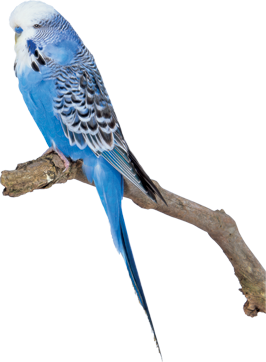Profiles
BUDGERIGAR
Bird lovers have been breeding budgies in captivity for over 150 years - since they were first domesticated in 1840.
They are the easiest members of the parrot family to breed.
Through years and years of breeding, budgerigars have developed many new colour variations. If you prefer, you can breed your budgerigars in separate cages, but they may also be bred out in an aviary as they are highly sociable birds that breed freely in colonies in the wild.
Sexing:
You can determine the sex of a budgerigar by looking at the colour of its cere. The cere is the fleshy area around your bird's nostrils, just above the beak. Adult male budgerigars have a blue or purple cere. Adult females have a brown cere, which deepens in colour when the female is ready for breeding. When your female is in good breeding condition she may also become destructive, tearing up tray liners and gnawing at perches. It is difficult to tell the sex of young budgerigars from the colour of their ceres, but that should not matter since you shouldn't be trying to breed your birds until they are over 10 months old.
Timing:
The best time of the year to breed budgerigars is in the spring. Although it is possible to breed them at other times of the year, it is not recommended. If you introduce nest boxes during the spring, your birds will be in peak breeding condition and your attempts to breed them will be best rewarded.
Nesting:
Once you are ready to breed, you should get your budgerigars a nest box. Nest boxes come in many designs but are generally open at one end. Normally, they are lined with a wooden or plastic nest pan which consists of a flat piece of wood with a depression hollowed out at one end where the female can lay her eggs. You do not need to add any other nesting materials.
Egg Laying:
Budgerigars typically lay a clutch of 4 to 6 eggs, although the clutch size can range anywhere from 1 to 8 eggs. The eggs are laid on alternate days and the incubation period is 18 days.
Diet:
Calcium is very important for the production of egg shells. Good sources of calcium for your laying hen bird are cuttlefish bone and grit. Soft foods like egg and biscuit mix along with soaked seed are also useful supplements during the breeding period.
Care of the young:
Budgerigar chicks are born blind and without feathers. While they are in the nest, which can be up to 24 days, they are completely dependent upon their parents for food. Once the chicks venture out of the nest, however, they will begin to make their own way and learn to feed themselves. Once they are around 32 days old, they should be fully independent, and can separate from their parents
